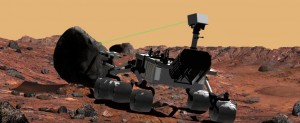
First color image of the Martian landscape returned from curiosity 08-06-12 (Image: NASA/JPL-Caltech/Malin Space Science Systems)
On its first full solar day on Mars, the Curiosity rover is under going a month-long series of health checks before getting down to its mission of exploring the chemistry of Mars.
Curiosity isn’t expected to drill its first drill hole in a Mars rock for about another month or two, according to Rob Manning, the Mars mission’s chief engineer.
However, we’re already getting some interesting images of the red planet.
Almost two hours after Monday’s touchdown, the rover started snapping pictures of its new home in Mars’ Gale Crater.
But even before that, some of Curiosity’s trip through the thin Martian atmosphere and subsequent landing were caught on camera by NASA’s Mars Reconnaissance Orbiter, which has been circling the planet for over six years.

Curiosity and its parachute were spotted by NASA’s Mars Reconnaissance Orbiter as Curiosity descended to the surface on 0500 UTC 08-06-12. (Image: NASA/JPL-Caltech/Univ. of Arizona)
The High Resolution Imaging Science Experiment (HiRISE) camera aboard the Mars Reconnaissance Orbiter, caught Curiosity while it was still connected to its almost 16-meter parachute as it descended to its landing site.
A camera aboard Curiosity itself took a sequence of self-portraits of its trip through the Martian atmosphere as well.
According NASA, the Mars Descent Imager (MARDI) snapped over 1,500 images which are being stored within Curiosity’s onboard memory banks. When those images are put together at the highest resolution, they should produce a video showing the rover’s descent from the time its heat shield was released, all the way until it touched down on Mars.
This stop-motion video shows 297 frames from the Mars Descent Imager aboard NASA’s Curiosity rover as it descended to the surface of Mars. (Video: NASA/JPL-Caltech)
Until we get that detailed video of Curiosity’s descent and touchdown, we’ll have to be satisfied with 297 color, low-resolution images the rover recently beamed back to Earth.

This image taken by Curiosity shows Mars’ Mount Sharp. The rover’s shadow can also be seen. (Image: NASA/JPL-Caltech)
“The image sequence received so far indicates Curiosity had, as expected, a very exciting ride to the surface,” says Mike Malin from Malin Space Systems in San Diego, the imaging scientist for the Mars mission. “But as dramatic as they are, there is real other-world importance to obtaining them. These images will help the mission scientists interpret the rover’s surroundings, the rover drivers in planning for future drives across the surface, as well as assist engineers in their design of forthcoming landing systems for Mars or other worlds.”
Other activities planned for the Curiosity today include setting up its high-gain antenna, collecting science data from the system’s Radiation Assessment Detector and Rover Environmental Monitoring Station instruments, as well as picking up additional imagery of its surroundings.
This is all part of the mission’s characterization activity phase, which tests how Curiosity’s subsystems and instruments are functioning after landing and within the environment and gravitational field of Mars.




 Science World is VOA’s on-air and online magazine covering science, health, technology and the environment.
Science World is VOA’s on-air and online magazine covering science, health, technology and the environment.